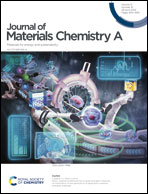An in situ hydrothermally self-crystallized dense ceria-based barrier layer for solid oxide fuel cells†
Abstract
This study introduces a novel approach for fabricating sub-micron dense GDC (Gd2O3 doped CeO2) barrier layers on YSZ (yttria-stabilized zirconia) electrolytes via in situ hydrothermal self-crystallization at an extremely low temperature of 180 °C. The dense GDC barrier layer self-crystallization in aqueous solution, was influenced by the orientation of the YSZ substrate. An anode-supported single cell with a GDC barrier layer ∼330 nm thick shows an Rohm of 0.075 Ω cm2 and PMax of 1.019 W cm−2 at 750 °C, which is a great improvement over single cell with a screen-printed GDC barrier layer (Rohm of 0.15 Ω cm2 and PMax of 0.661 W cm−2) and shows enhanced durability over 800 h. This enhanced performance is primarily due to shortend oxygen ions transport pathways, and an optimized electrolyte/cathode interface from effective interface sintering. This in situ hydrothermal self-crystallization method emerges as a promising and applicable technique for the preparation of a thin-film GDC barrier layer.



 Please wait while we load your content...
Please wait while we load your content...